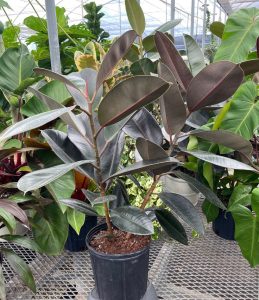Ficus Elastica

- Botanical Name: Ficus Elastica
- Family Name: Moraceae
- Stems: 2-50 Feet
- Temperature: 20°C〜25°C
- Others: Prefers fertile soil, enjoys sunlight, tolerates shade, not cold-resistant.
Overview
Product Description
Ficus Elastica: The Tropical Titan’s Reign in Diverse Realms
Ficus Elastica: The Indian Rubber Plant’s Tropical Origins
Ficus elastica, also known as the Indian Rubber Plant, is a tropical tree species native to Bhutan, Sikkim, Nepal, northeastern India, Burma, northern Malaysia, and some parts of Indonesia. In China, wild populations can be found in certain areas of Yunnan, particularly at altitudes ranging from 800 to 1500 meters.

Ficus Elastica
Growth Environment and Temperature Adaptability
The Ideal Home of Warmth and Humidity
Ficus Elastica prefers warm, humid, and sunny growing conditions, showing strong shade tolerance, but should avoid prolonged exposure to direct sunlight to prevent leaf damage. They are also not adapted to cold climates, with an optimal growth temperature range of 15 to 35 degrees Celsius, and winter temperatures should not fall below 5 degrees Celsius to ensure safe overwintering.
Lover of Fertile and Moist Soil
It has specific preferences for soil, favoring fertile and moist acidic soils. This plant has high water requirements and is not suitable for growth in arid environments. Therefore, maintaining moderate soil moisture is key to the healthy growth of Ficus elastica.
Adaptable to Light Changes
It has a strong adaptability to light conditions, thriving in various light intensities. From bright diffused light to partially shaded environments, It can maintain its vitality, showing its flexibility as an indoor plant.
Winter Blooms and Propagation
The flowering period of Ficus elastica is mainly concentrated in winter, and although their flowers are small, they are crucial for plant reproduction. There are various methods of propagation, and Ficus elastica can be propagated through seeds, as well as through cuttings and layering, making it easy to cultivate and spread in horticulture.
Ficus Elastica: The Majestic Titan of the Tropical Rainforest
The Grace of Trunk and Branches
The Indian Rubber Plant is known for its robust trunk and elegant branches. Mature Indian Rubber Plants can grow into small to medium-sized trees with a stout trunk, up to 1 meter in diameter, marked with distinct annular leaf scars that record the passage of time. The trunk is usually upright and straight, while its branches hang low, naturally forming an umbrella-shaped canopy that showcases a harmonious balance.
The Luster and Form of the Leaves
The leaves of the Indian Rubber Plant are the epitome of its charm, with alternate leaves that are elliptical to inverted oval, reaching up to 20 centimeters in length and 10 centimeters in width. The leaf tips are sharp, the base is wedge-shaped, and the edges are entire or slightly wavy, adding a touch of liveliness. The surface of the leaves is smooth and shiny, with colors ranging from deep green to light green, sometimes adorned with yellow or white variegations that shimmer with vitality under the sunlight.
The Uniqueness of Aerial Roots
A notable feature of the Indian Rubber Plant is its aerial roots, which hang down from the branches, adding visual appeal and the ability to absorb moisture and nutrients from the air. These aerial roots, when touching the ground, take root and form new trunks, a unique strategy for the plant’s asexual reproduction and adaptation to its environment.
The Versatile Conqueror of Diverse Realms
The Vitality of Flowers and Fruits
The flowers of the Indian Rubber Plant are small and typically unisexual, with separate male and female plants, while the fruits are spherical, about 1-2 centimeters in diameter, turning yellow-green when ripe and containing numerous small seeds. These details, though small, carry the continuation and propagation of life, reflecting the vitality and natural beauty of the Indian Rubber Plant as a living organism. The bark is rough and gray-brown, gradually cracking as the tree ages, revealing the marks of time. The Indian Rubber Plant grows rapidly, especially in suitable climates and soil conditions, showing a vibrant vitality.
The Sovereign of Horticulture and Décor
Ficus elastica, with its majestic presence and versatile uses, reigns as a standout in horticulture and indoor decoration. This plant is not only widely distributed in the streets and parks of tropical regions but also holds a significant place in indoor adornment, adding a touch of vitality and dynamism to the environment with its unique form and growth characteristics.
Pioneer in Ecology and Energy
The aerial roots of the Indian Rubber Plant not only demonstrate their unique mechanical strength in ecological engineering but are also used to construct living root bridges, showcasing the infinite possibilities of plant-based construction. Moreover, its latex as a source of natural rubber, along with the high calorific value of its plant samples, indicates its potential in energy development and biomaterials. Additionally, the medicinal value of Ficus elastica should not be overlooked, with its leaf extracts showing broad applications in antibacterial and pharmacological activities. Ficus elastica is undoubtedly a versatile player in the fields of ecology, energy, and medicine.










